INDONESIA AND THE BLOODY OBLIVION OF THE WEST
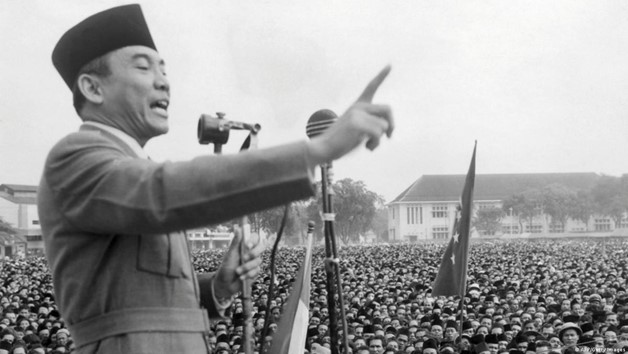
‘The only way not to go mad was to drink the blood of the communists we were killing: if you can drink their blood you know you can do anything’. This is not a line from a Quentin Tarantino film, but the testimony of a militiaman of the death squads that, in the space of little more than five months, between the end of 1965 and the beginning of 1966, became the murderous hand of General Haji Mohammad Suharto’s army – over a million dead: shot, their throats slit, beheaded, brutally mutilated.
The phrase comes from Anwar Congo, one of the many murderers of the extermination and improvised actor in ‘The Act Of Killing’, a 2012 documentary by Joshua Oppenheimer[1] that retraces those terrible months: Anwar, together with Adi Zulkadry, then a gangster and now a respectable member of a security company, tells of having killed at least 1000 ‘communists’ and of not even knowing why: ‘It just had to be done, and we were trying to do it as quickly and as well as possible’. In the film, he does not fail to describe in detail the techniques used to kill. Today, he is one of the few in whom a glimmer of repentance seems to surface, and who tells of his nights troubled by ghosts.
Around him, even among ordinary people, the idea that he did the right thing is widespread: anti-communist sentiment is still alive today, perhaps also because the political protagonists of the time still fill the seats of power undisturbed. Almost 60 years have passed since one of the most impressive, heinous, brutal, bloody massacres that world history has ever recorded – a genocide too often forgotten, unleashed by a hammering propaganda concocted by the United States and the United Kingdom that demonises anyone who does not align themselves with a puppet government headed by Suharto, installed after an attempted coup d’état that is still obscure today.
The leader and the resistance
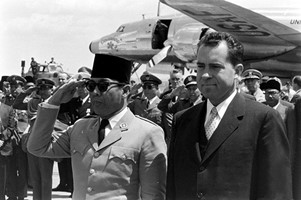
Sukarno welcomed by Richard Nixon in 1956[2]
Kusno Sosrodihardjo, better known as Sukarno or Bung Karno, is the first Indonesian president after the proclamation of independence (1945) and has the difficult task of leading the country, torn by tribal and religious violence, until the proclamation of the ‘Republic of Indonesia’[3] . Sukarno played a key role in shaping the new nationalist consciousness in response to the expansion of colonial power over the economic, political and social life of the Indies. The Netherlands, during its colonial hegemony, attempted to implement a modern entrepreneurial economy through tight political control and the dismantling of traditional economic and social models – but the result was the emergence of strong social discontent and rabid nationalist sentiments, of which Sukarno became the representative[4] .
In 1928 Sukarno assumed the presidency of the Indonesian Nationalist Party (PNI): his speeches, peppered with impassioned rhetoric, made him an enemy for the Dutch: arrested during a purge and sentenced to four years’ imprisonment, he managed to return free after a year – with even more strength and charisma. In 1931 he is, in the collective imagination, the undisputed key figure of Indonesian nationalism and independence movement, and nothing changes for a new arrest (1933) and exile on the island of Sumatra[5] .
In 1942, Japan invaded the East Indies and tried to use Sukarno to gain popular acceptance and convey the image of Japan as liberator. Sukarno, in turn, succeeded in using Tokyo to lay the foundations for self-government: during the occupation, the nationalist leader created an effective system of advisory councils through which Indonesians began to participate in the politics of the archipelago. In 1943, the Japanese army formed the voluntary army of the National Defence Corps PETA (Pembela Tanah Air) to repel the invasion of the Allied forces in the East Indies – the organisation later became the core of the army of independent Indonesia[6] .
Sukarno is increasingly the glue of the Indonesian people, thanks in part to a common feeling of belonging as expressed in the Pancasila, a philosophical thought based on five fundamental principles: nationalism, internationalism or humanitarianism, democracy, social prosperity and faith in God[7] , all seasoned with a syncretism inherent in Indonesian culture that helps overcome differences in religious beliefs[8] .
The CIA lands in Jakarta

President Sukarno with US Secretary of State Dean Rusk and Vice President Lyndon Johnson[9]
On 15 August 1945 came the surrender of Japan and two days later Sukarno declared the independence of the Republic of Indonesia. The next day he took over as President of the Republic and promulgated the first Constitution, based on Pancasila thought: this was the beginning of the Indonesian revolution, during which Sukarno remained the main and undisputed authority. The Netherlands, for almost four years, deploys every possible strategy to obstruct the recognition of the new republic and establish a sort of federation between Dutch and Indonesians. The conflict resulted in several Dutch military attacks between 1947 and 1949: Sukarno was again arrested, but then freed following pressure from the United Nations, which in June 1949 led to a truce and Sukarno’s return to Java, this time with American protection: the following month Holland accepted the country’s independence[10] .
What has changed? The end of the war prompts Washington to change the international diplomatic network and the activities of the OSS (Office of Strategic Services, military intelligence service), an agency that finds itself going through an ambiguous phase, from the mists of war to the mists of peace: its officers question their future[11] . Washington responds: the OSS is to be abolished, and in its place is to take shape the Strategic Services Unit (SSU), an organisation with the operational capabilities of the OSS and with foreign intelligence and counter-espionage functions. The centralisation, desired in 1947 by OSS chief William Donovan, is the prelude to the birth of the Central Intelligence Agency (CIA)[12] .
In the Pacific Ocean, all war missions become diplomatic espionage and counter-espionage missions. The war is over, but not quite. Frederick E. Crockett, an OSS officer, immediately after the Japanese surrender on 15 September 1945, arrives in the port of Tanjung Priok in Jakarta with the British warship HMS Cumberland: under the umbrella of Operation Everest, Crockett is to assist the repatriation of US troops captured by the Japanese and open a CIA coordination office, which from Jakarta also opens increasingly organised intelligence stations in Saigon (now Ho Chi Minh City) and Singapore[13] .
In Jakarta, the pioneer who first took charge of the agency’s start-up was the former Indonesian partisan officer, Zulkifli Lublis: his men, who had fought in the jungle in the irregular PETA militia, were trained by the CIA to be a special corps, made up of at least 40 elements chosen from among former Indonesian officers and Japanese informers[14] . The aim is to control any deviationism throughout Indochina – and especially in Vietnam[15] .
Jakarta is celebrating a season of parliamentary democracy (1949-1958), a period during which Sukarno, as President of the Republic, assumes only an honorary function, while the real executive powers are in the hands of the Prime Minister. It was not an easy period, marked by the fall of several governments and numerous rebellions against the central power. During this phase, and exactly on 29 September 1950, Indonesia joined the UN[16] . In the instability, Sukarno is adept at strengthening his power. When he decides to act, it is against the Western model of liberal democracy and replaces it with a system of ‘guided democracy’: a model based on tribal tradition, village assemblies, the musyawarah (an assembly composed not only of political parties, but also of urban workers, rural farmers, intellectuals, entrepreneurs, religious organisations, armed forces, youth and women’s associations, etc.), headed by a leader, the mufakat, who represents the wishes of the musyawarah in the seats of central power[17] .
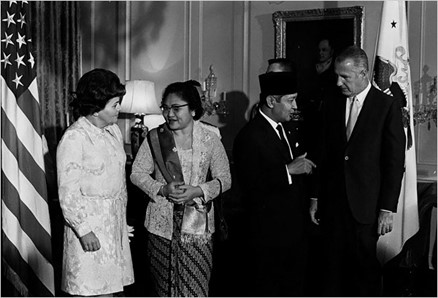
Washington, May 1970: Suharto with US Vice President Spiro Agnew and their wives[18]
The year is 1959, and a new political phase begins, characterised by the abolition of parliament and the reintroduction of the presidential system supported by the army. The parties were reduced to ten, and among these, the only one that enjoyed the possibility of political action – and competed with the army to increase its power – was the Indonesian Communist Party (PKI), a party towards which Sukarno moved closer and closer, at the same time as relations with China and Russia intensified: Between 1961 and 1962, Jakarta purchased tactical nuclear weapons and short-range rockets, cruise missiles and manned bombers from the Soviet Union, a strategy that clearly shows how the Russians were offering their support for a war effort against the Dutch in the New Guinea case[19] .
The operation sheds new light on Khrushchev’s foreign policy in the early 1960s[20] . We are in the midst of the Cold War. In 1963, Sukarno allowed himself to be appointed Head of State for life: the models of ‘guided democracy’ and ‘guided economy’ increasingly took on the characteristics of a bloody dictatorship, which, together with a mad and lavish leadership in search of popular consensus, thanks also to a cabinet consisting of dozens of cynical and corrupt ministers, led to a constant state of national crisis[21] . This brings with it consequences: Sukarno, by flanking the PKI, dangerously upsets the balance between the three pillars that had hitherto supported Indonesia (army, Islam and communism) and, in 1965, something happens that completely reshapes the top echelons of power and triggers one of the most ferocious massacres in the history of mankind can remember.
The coup d’état

Jakarta, 30 September 1965: the Indonesian army rounds up suspected communist militants in the street who are shot a few minutes later[22]
The events of the coup d’état are still confused to this day: on 30 September 1965 and the days that followed, in fact, no matter how much research there is into documentation, testimonies and newspaper reports, the historical truth is still a long way from being achieved. Rumours circulate of the existence of a so-called council of right-wing generals supported by the CIA and who would sooner or later betray Sukarno[23] . During the night of 30 September, several middle-ranking officers raided the homes of a dozen of their superiors (including the army commander, General Ahmad Yani[24] ), with the intention of kidnapping them; during the operation, three of them were killed, the others were taken to an airbase and executed. Only one of them, General Abdul Haris Nasution, managed to escape[25] .
The rioters occupy Merdeka Square and the national radio station. At the end of the day, Lieutenant-Colonel Untung bin Syamsuri, through the microphones of the radio station, announces that he and other officers gathered in the ’30 September Movement’ had foiled a coup d’état organised by ‘power-crazed generals supported by the CIA’ and that everything boils down to an ‘internal army matter’: Sukarno is safe[26] . According to the official narrative, during the early hours of 1 October, Brigadier General Suharto, a bitter enemy of Islam and communism[27] , warned of the attempted coup, mobilised special forces to retake control of downtown Jakarta. According to the testimony of Colonel Abdul Latief, Suharto was warned a good six hours before the attempted coup – but Suharto does nothing, he waits[28] .
At nine o’clock in the evening, after taking command of the ABRI (Angkatan Bersenjata Republik Indonesia), Suharto announces on radio microphones that the six generals have been kidnapped by the ‘counter-revolutionaries’ and that the ’30 September Movement’ intends to overthrow Sukarno – and that everything is now under the control of the army: the 30 September Movement is annihilated with the attack on the Halim airbase, where the coup plotters took refuge, dragging Sukarno and the PKI leader Dipa Nusantara Aidit, now freed, as hostages in addition to the generals[29] . For Suharto it is the great opportunity: to exploit the events for fierce anti-communist propaganda, eroding Sukarno’s power day after day.
Suharto unleashes a furious hunt for the ‘communist’: within weeks, the military propaganda machine spreads news that the entire PKI is the author of a massive conspiracy and that the assassination of the generals is only the first step in a planned communist takeover. Objective: to exterminate all enemies of the party on a very large scale. The narrative that party members throughout the country are planning the murder of their neighbours becomes a formidable trigger – a campaign in which the US, UK and Australia actively participate – which soon triggers an intense rounding up activity that culminates in summary executions, first against army elements loyal to Sukarno or politically suspect, then against PKI cadres and sympathisers, then against ordinary citizens without any regard for old people, women and children[30] .
The purge begins in Aceh, in the extreme north-western tip of Sumatra, and then spreads across the whole island[31] . Soon, the extermination spreads across the island of Java to Bali – everywhere a ruthless machine is activated, imprisoning hundreds of thousands of citizens for no reason at all, labelled as communists just because they are peasants, intellectuals, artists, students or trade unionists, of Chinese ethnicity or simply because they are poor, only to be barbarously exterminated together with their relatives, children and grandchildren, without even a summary trial.
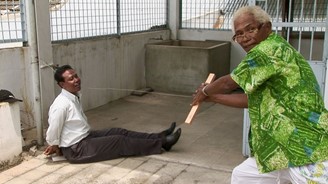
The ‘gangster’ leader Anwar Congo reconstructs, in a scene from the docufilm ‘The Act Of Killing’, one of the killing techniques: this one illustrated has the advantage of shedding ‘little blood’[32]
The round-ups and mass killings have no uniform matrix. The main actor is the regular army loyal to Suharto, which plays a key role in recruiting, arming and training militia units to carry out the killings. It must be said that not all of the army takes part in the operations: several battalions, including the Diponegoro division in Central Java and a significant number of air force officers are in fact strongly in tune with the PKI, a party that in those years counts the membership of at least 3.5 million members and a further 23.5 million members in affiliated organisations: it is the third largest communist party in the world after the Chinese and Russian, the largest non-powerful communist party[33] .
Part of the army is therefore very active in the extermination, but it does so without getting its hands dirty: the actions aim at recruiting and inciting local militias or paramilitary groups for civil defence and the defence of the people, leaving the atrocious manoeuvres to them, trying to build death squads by also exploiting gangs of thugs (the preman or ‘gangsters’[34] ), organised criminal groups but also religious groups such as Islamic groups, Christian groups in Java or Hindu groups in Bali[35] ready to carry out the massacres against the communist ‘unclean beasts’ that are, according to the propaganda, everywhere; for criminal groups it is also a rich opportunity to steal, plunder entire families of their belongings and rape their women.
Among the most active groups in the slaughtering is Pemuda Pancasila (or Pancasila Youth), an extreme right-wing paramilitary organisation descended from the youth wing of the League of Supporters of Indonesian Independence, established by General Abdul Haris Nasution in 1959 in defence of the political interests of the Indonesian army, today with three million members. The group, dedicated to extortion, gambling control and numerous other criminal activities, supports the regime[36] . Suharto himself uses Pemuda Panca Marga[37] – another extreme right-wing organisation that defends the crimes against humanity perpetrated by the government[38] – and the Indonesian Retired Boys and Girls Communication Forum (FKPPI) – an organisation very similar to the PPM – to intimidate and attack opponents and critics of the government[39] .
In a scene from the film ‘The Act Of Killing’, the vice-president of Indonesia himself, during a rally of supporters of the organisation, shows up to praise the work of Pemuda Pancasila: “We need gangsters to get things done!”, clear words that legitimise criminality as an instrument of political power still in today’s Indonesia[40] . Militias capture civilians who are summarily interrogated and tortured. After interrogation, prisoners are divided into three categories according to their alleged level of involvement in the 30 September Movement, some are transferred to penal colonies, detention facilities and concentration camps under military command, while others are transported by military vehicles, death squads or anti-communist militias to extermination sites to be executed[41] .
The barbarities are carried out by any means: torture, shootings, decapitations, stranglings, bodies burnt and cut to pieces; in this orgy of horrors, women, old, sick people and children are not spared; the shops, offices, houses and any property of anyone suspected is destroyed: the objective is to wipe out forever anything that could lead back to the communist ideology, and it must be done with the greatest possible brutality, so that it may be an example to public opinion. In a short time, the murderous madness pervades every street in every village, contaminating even ordinary citizens, who are pervaded by a terrible feeling: “either you kill or you are killed”[42] .

Japto Soerjosoemarno, leader of Pemuda Pancasila[43]
The massacres lasted several months: estimates of the number of people killed cannot be based on reliable documentation, due to the absence of official records and the unwillingness of the regime to shed light. To date there is probably talk of more than one million people murdered, but some scholars think the numbers may be as high as three million. President Sukarno himself activates a team to investigate the murders in December 1965, but the number of victims calculated by this entity is highly uncertain, as the count takes place before the murders are over.
A KOPKAMTIB (Komando Operasi Pemulihan Keamanan dan Ketertiban) survey carried out in 1966 arrives at an estimate bordering on a million deaths, but even here doubts about reliability are high: the survey takes place in a period amidst strong political pressures that operate both to cover up the facts and to emphasise them – until the late 1990s and the end of the Suharto regime, there will never be any political will or interest in bringing the mass graves to light – moreover, it is carried out on the estimated remains count, a totally unreliable operation given that a large number of bodies will never be found because they were burnt, buried, torn to pieces, thrown into wells, ditches, lakes, irrigation canals and rivers, or quickly decomposed due to the hot-humid Indonesian climate and therefore dispersed forever[44] .
In addition to those killed, between 600,000 and 750,000 people remain in concentration camps for periods of between one and thirty years, often subjected to rape and torture: many men and women die in detention. Those released are prevented from working as teachers, lawyers, journalists, civil servants and military personnel[45] .
Washington and London knew
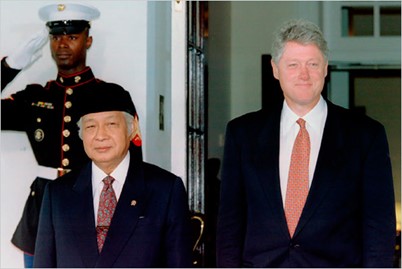
October 1995: Suharto and Bill Clinton[46]
Various theories have been used to explain the events over time: according to some, the matrix of the coup was the PKI, which carried it out in an attempt to establish a communist government, which failed thanks to the army’s response and subsequent communist purges. For some others, it was a staged coup by Suharto, a coup organised with the aim of eliminating Sukarno and the PKI. A third theory is related to the Cold War and explains Sukarno’s fall as orchestrated by the US, so as to remove the leader of a rising power that was gradually approaching Moscow and Beijing.
Jess Melvin, a researcher in the Department of History at the University of Sydney, disproves the Suharto government’s version of the massacres, according to which spontaneous movements led by the people angry at the PKI for killing the generals are to blame. According to many military documents, to which the professor gained access in 2010, another truth shines through: the army had been meticulously planning the coup for at least a year with the recruitment of civilian militias[47] . This was because concern had already been mounting in the military leadership for some time over Sukarno’s activities to weaken the army, especially after his declarations that he wanted to support the PKI’s desire to establish a ‘Fifth Force’, i.e. a military structure controlled by the party[48] .
These documents also show that the United States and the United Kingdom were fully aware of the rebellion plan implemented by the 30 September Movement[49] . The thesis of active US involvement is confirmed when, in 2017, further documents are declassified and published by the National Security Archive[50] : these are documents from the US Embassy in Jakarta that describe the activities of that period and demonstrate the full awareness of diplomats and their counterparts in Washington of the implementation of the massacres.
Human Rights Watch states that “these documents make clear that US officials had detailed knowledge of the mass killings in Indonesia in 1965-66.” And it warns: ‘The US government must now release the remaining documents, not only for the historical record of one of the worst atrocities of the 20th century, but as a long overdue step towards reparations for the victims’[51] . Professor Geoffrey Robinson, whose book ‘The Killing Season: A History of the Indonesian Massacres, 1965-66’[52] is considered the best work ever published on the subject, argues that, based on the documents found in the US and British archives, the full awareness of both countries of the massacre and their encouragement of the elimination of the Communist Party by supporting the military dictatorship of General Suharto, who remained in power until 1998, is evident. This support is not limited to the provision of military aid, but is also expressed in the intensification of economic relations[53] .
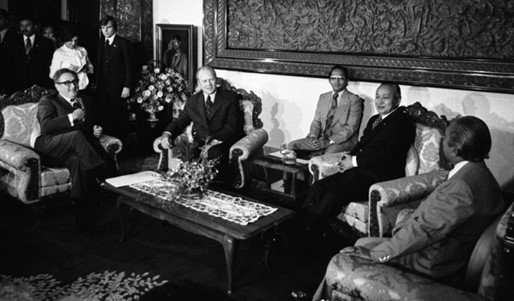
6 December 1975: Suharto with US President Gerald Ford and Secretary of State Henry Kissinger one day before the invasion of East Timor[54]
The Israeli Foreign Ministry also opens its archives: documents reveal negotiations for the supply of Israeli weapons to the Indonesian army as early as 1957 – light weapons and hand grenades, sold with the consent of the Netherlands[55] . In a telegram dated 15 April 1958, Shmuel Bendor, Israel’s representative in Czechoslovakia, reports a meeting with the Indonesian ambassador in Prague, who complains to him about the US claims: ‘They say that Indonesia is heading towards communism. This is madness. Indonesia does not want to belong to any international bloc, because we do not believe that the world is divided into two parts’. The statement is particularly interesting, as it emphasises the US vision of the time, which divides the entire globe into communists and anti-communists – a vision, called the ‘Truman doctrine’, which, wanting to prevent Soviet expansion, leads the US to the fulfilment of countless interferences against foreign governments for more than half a century[56] .
A few months later, Israel decided to break off the war supply negotiations, mainly for three reasons: the refusal of Indonesia (an Islamic country) to establish formal diplomatic relations with Israel, the impossibility of the negotiations remaining secret, and the real possibility that the supply would seriously endanger Israel’s relations with other states in the region[57] .
A genocide still unpunished
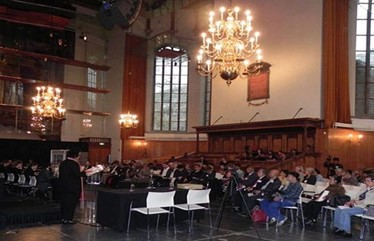
Nursyahbani Katjasungkana, coordinator of the International People’s Tribunal, gives her opening speech at the Nieuwe Kerk in The Hague[58]
The total lack of interest around the mass killings perpetrated in those years is unbearable. Not even the film ‘The Act of Killing’ (which shows with lucid rawness the terrible crimes against humanity committed from 1 October 1965 onwards) or the touching film ‘The Look Of Silence’[59] (in which the unpunished gaze of the murderers mingles with the eyes of the victims’ relatives, in search of a truth that can somehow make sense of their actions), despite being accompanied by a lot of media noise, managed to shake the conscience of the international community. During the ten years that have passed since the end of the Suharto regime, some initiatives emerge at the state level to address human rights violations: the National Human Rights Commission is given the mandate to investigate the detention and inhuman treatment of prisoners sent to Buru Island[60] , but it is a very narrow investigation and the commissioners are given a very short time to complete their research: their conclusions will have no follow-up .[61]
In December 1999, two months after his election, President Abdurrahman Wahid, during meetings of the ‘1965 exiles’ at the Indonesian embassies in The Hague and Paris, publicly apologised for the killings, but the apology was not followed up[62] . In 2004, parliament passed a law allowing the formation of a Truth and Reconciliation Commission (TRC): the commission was abandoned in 2006 after the Constitutional Court declared the TRC law unconstitutional[63] .
Since 2008, the Indonesian Human Rights Commission has been trying to launch new investigations by gathering evidence and testimony, but is regularly stopped by intimidation and violence that makes it impossible to carry out its work[64] . On 18 March 2014, a body made up of Indonesian exiles in the Netherlands and Germany and international researchers was set up, through The International People’s Tribunal Foundation, to deal with the crimes of 1965: this body receives no legitimacy from the Indonesian government and therefore only has the role of a human rights tribunal, it only has the power to admonish but no power to impose.
The tribunal avails itself of dozens of researchers and direct witnesses, gathers evidence and documents. The Indonesian government is invited to the hearings, which take place at the Nieuwe Kerk, in The Hague, from 10 to 13 November 2015, but refuses to attend and make submissions. A team of prosecutors, led by lawyer Todung Mulya Lubis, compiles a list of nine counts against the Sukarno regime for crimes against humanity. On 20 July 2016, Chief Judge Zak Yacoob came to the verdict: the state of Indonesia is guilty of mass killings, genocide, torture, enforced disappearance and sexual violence, and all crimes were committed under the full responsibility of the state[65] .
An interesting chapter opens on the complicity of other states: according to the judgment, ‘the diplomatic and propaganda apparatuses of the United States, Great Britain and Australia actively contributed to false anti-communist propaganda with the aim of manipulating opinion in favour of the Indonesian army (and against President Sukarno), in the full knowledge that the army was preparing to “execute or encourage” such large-scale killings’[66] . “The United States also provided material aid to the Indonesian army in at least two specific instances in the full knowledge that these would aid these acts: (a) the supply of small arms and communications equipment; and (b) the supply of a list of known communists; and Britain eased the pressure on the Indonesian army in the ongoing undeclared war on the Indonesian-Borneo border, once again to enable the army to continue its anti-communist purge”[67] .
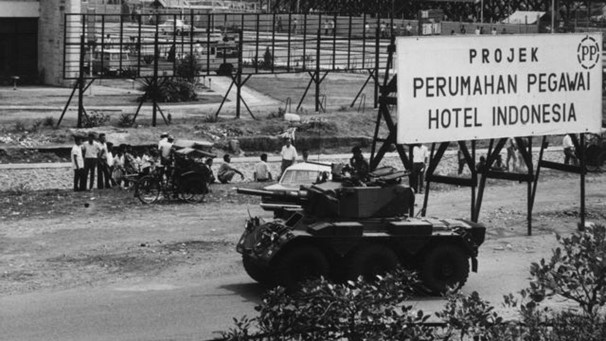
October 1965: Indonesian troops prepare to shoot citizens rounded up in the streets of Jakarta[68]
The Tribunal’s conclusions are lapidary: ‘The United States gave sufficient support to the Indonesian army, knowing full well that they had embarked on a programme of mass killings, for our accusation of complicity to be justified. The existing British and Australian propaganda operations were part of that undeclared war. Both governments shared the objective, set by the United States, of seeking the overthrow of President Sukarno’[69] .
The tribunal recommends that the Indonesian state apologise to all victims, survivors and their families for its actions, investigate and prosecute all crimes against humanity, and provide victims and survivors with adequate compensation and reparations. To date, none of these recommendations have been positively addressed[70] . Only recently, in January 2023, Indonesian President Joko Widodo publicly expressed regret for the ‘grave human rights violations’ that have taken place in his country, but human rights groups consider Widodo’s regret insufficient: what is still missing is a true judicial process of the crimes and their perpetrators[71] .
Impunity for the crimes of 1965 still has consequences today: the murderers of that time walk free and occupy, undisturbed, positions of power, while the victims and their families are forced to face permanent stigma, marginalisation and economic deprivation, immersed in the frustrating helplessness of not being able to obtain justice. Impunity is a social cancer that strikes deep into Indonesian society, a state where human rights struggle to gain the respect they are due. Laws have been reinstated that severely restrict freedom of expression, peaceful assembly and association, violate privacy and sexual and reproductive rights, and discriminate against women, LGBT people and minorities: extramarital relationships are criminally condemned and treated with caning. Excessive use of arrest and violence with torture and killing is the norm, even against journalists[72] .
This is morally unacceptable and pragmatically wrong: Indonesia, a country with more than 280 million inhabitants divided into some 400 ethnic groups and speaking 742 different languages and dialects, is a market almost as big as Europe in need of help, but its economic, military and technological strength is growing – its influence on the Far East is now greater than Japan’s: the political class has an atrocious past it cannot come to terms with, but the West has its own grave responsibilities. It would help if the mea culpa started in London and Washington. Unfortunately, the signs are not encouraging since, half a century after the horror, the American politician running around Asia is still the same: Henry Kissinger.
JPN004
[1] https://www.mymovies.it/film/2012/theactofkilling/
[2] https://www.wowshack.com/20-photos-of-president-soekarno/
[3] https://www.jstor.org/stable/3351273
[4] https://scholarworks.uvm.edu/cgi/viewcontent.cgi?article=2394&context=graddis Thomas Joseph Butcher: ‘Developing Identity: Exploring The History Of Indonesian Nationalism’ – University of Vermont (2021)
[5] https://scholarworks.uvm.edu/cgi/viewcontent.cgi?article=2394&context=graddis Thomas Joseph Butcher: ‘Developing Identity: Exploring The History Of Indonesian Nationalism’ – University of Vermont (2021)
[6] https://academic-accelerator.com/encyclopedia/proclamation-of-indonesian-independence
[7] https://www.britannica.com/topic/Pancasila
[8] https://www.tandfonline.com/doi/abs/10.1080/03062849108729769?journalCode=cimw19
[9] https://www.lifegate.it/storia-genocidio-indonesia-suharto-1965
[10] https://academic-accelerator.com/encyclopedia/proclamation-of-indonesian-independence
[11] https://www.cia.gov/static/f3d10e5db051e88bb353fdce70870abe/Transitioning-into-CIA.pdf
[12] https://www.cia.gov/static/f3d10e5db051e88bb353fdce70870abe/Transitioning-into-CIA.pdf
[13] https://news.detik.com/x/detail/intermeso/20171005/James-Bond-Indonesia-Dilatih-CIA-dan-Mossad/
[14] https://news.detik.com/x/detail/intermeso/20171005/James-Bond-Indonesia-Dilatih-CIA-dan-Mossad/
[15] https://www.hachettebookgroup.com/titles/vincent-bevins/the-jakarta-method/9781541724013/?lens=publicaffairs “The Jakarta Method” – Vincent Bevins – PublicAffairs – 2020
[16] https://indonesia.un.org/en/about/about-the-un
[17] https://www.britannica.com/place/Indonesia/Independent-Indonesia-to-1965#ref315000
[18] https://www.nytimes.com/slideshow/2008/01/27/world/0127-SUHARTO_index/s/0108-SUHARTO_slide7.html
[19] https://www.abebooks.it/9780393040708/Gamble-Khrushchev-Castro-Kennedy-1958-1964-0393040704/plp Aleksandr Fursenko and Timothy Naftali, ‘One Hell of a Gamble’; https://www.tandfonline.com/doi/full/10.1080/08850607.2021.1874191 Khrushchev, Castro, Kennedy and the Cuban Missile Crisis, 1958-1964 (London: Pimlico, 1999), 188, 210, 217.
[20] https://www.sup.org/books/title/?id=7853 Bradley Simpson, Economists with Guns: Authoritarian Development and US-Indonesian Relations, 1960-1968 (Stanford: Stanford University Press, 2008)
[21] https://www.britannica.com/biography/Sukarno
[22] https://www.smithsonianmag.com/smart-news/declassified-records-show-us-knew-about-supported-1965-massacre-indonesia-180965326/
[23] https://jacobin.com/2022/02/suharto-indonesia-us-coup-communism-history-mass-murder-postcolonial-state
[24] https://ecommons.cornell.edu/bitstream/handle/1813/54439/INDO_85_0_1211483260_165_170.pdf?sequence=1&isAllowed=y
[25] https://www.britannica.com/event/September-30th-Movement
[26] https://jacobin.com/2022/02/suharto-indonesia-us-coup-communism-history-mass-murder-postcolonial-state
[27] https://books.google.it/books/about/Suharto.html?id=ElTYvtijU6AC&redir_esc=y : Elson, Robert Edward (2001). “Suharto: A Political Biography” Cambridge University Press.
[28] https://www.dw.com/id/suharto-dalam-tradisi-politik-dan-militer/a-19303991
[29] https://jacobin.com/2022/02/suharto-indonesia-us-coup-communism-history-mass-murder-postcolonial-state
[30] https://www.amazon.it/Global-Cold-War-Interventions-Making/dp/0521853648 ; Westad, Odd Arne (2005). ‘The Global Cold War: Third World Interventions and the Making of Our Times’. Cambridge: Cambridge University Press. ISBN 978-1-139-64382-5
[31] https://jacobin.com/2022/02/suharto-indonesia-us-coup-communism-history-mass-murder-postcolonial-state
[32] https://it.wikipedia.org/wiki/L%27atto_di_uccidere#/media/File:The_Act_of_Killing_-Trailer.jpg
[33] https://www.sciencespo.fr/mass-violence-war-massacre-resistance/fr/document/indonesian-killings-1965-1966.html
[34] https://dbpedia.org/page/Preman_(Indonesian_gangster)
[35] https://jacobin.com/2022/02/suharto-indonesia-us-coup-communism-history-mass-murder-postcolonial-state
[36] https://www.amazon.it/Violence-Suhartos-Indonesia-Benedict-Anderson/dp/087727729X ; Benedict R. O’G. Anderson – ‘Violence and the State in Suharto’s Indonesia’ (2000)
[37] https://pemudapancamarga.com/
[38] https://www.routledge.com/Un-Civil-Society-and-Political-Change-in-Indonesia-A-Contested-Arena/Beittinger-Lee/p/book/9780415836760 ; Verena Beittinger-Lee – “(Un)Civil Society and Political Change in Indonesia: A Contested Arena” – Routledge (2013) – page 175
[39] https://voi.id/en/memori/39901
[40] https://overland.org.au/2013/08/we-need-gangsters-to-get-things-done/
[41] https://www.972mag.com/israel-whitewash-indonesia-anti-communist-massacres/
[42] https://www.sciencespo.fr/mass-violence-war-massacre-resistance/fr/document/indonesian-killings-1965-1966.html
[43] https://voi.id/en/memori/39901
[44] https://www.sciencespo.fr/mass-violence-war-massacre-resistance/fr/document/indonesian-killings-1965-1966.html
[45] https://www.sciencespo.fr/mass-violence-war-massacre-resistance/fr/document/indonesian-killings-1965-1966.html
[46] https://www.nytimes.com/slideshow/2008/01/27/world/0127-SUHARTO_index/s/0108-SUHARTO_slide10.html
[47] https://brill.com/view/journals/bki/176/2-3/article-p373_6.xml
[48] https://brill.com/view/journals/bki/176/2-3/article-p373_6.xml
[49] https://www.thejakartapost.com/academia/2020/09/30/55-years-of-impunity-how-indonesia-is-going-backwards-after-the-1965-genocide.html#google_vignette
[50] https://nsarchive.gwu.edu/about
[51] https://www.hrw.org/news/2017/10/18/indonesia-us-documents-released-1965-66-massacres
[52] https://press.princeton.edu/books/hardcover/9780691161389/the-killing-season
[53] https://www.972mag.com/israel-whitewash-indonesia-anti-communist-massacres/
[54] https://www.972mag.com/israel-whitewash-indonesia-anti-communist-massacres/
[55] https://www.972mag.com/israel-whitewash-indonesia-anti-communist-massacres/
[56] https://www.972mag.com/israel-whitewash-indonesia-anti-communist-massacres/
[57] https://www.972mag.com/israel-whitewash-indonesia-anti-communist-massacres/
[58] https://indonesiaatmelbourne.unimelb.edu.au/the-ipt-1965-is-a-historic-moral-intervention-will-it-finally-lead-to-action/
[59] https://www.cinematografo.it/recensioni/the-look-of-silence-qnubpueg
[60] https://brill.com/display/book/9789004512573/BP000014.xml?language=en
[61] https://www.sciencespo.fr/mass-violence-war-massacre-resistance/fr/document/indonesian-killings-1965-1966.html
[62] https://www.tandfonline.com/doi/full/10.1080/14623528.2017.1393970
[63] https://www.sciencespo.fr/mass-violence-war-massacre-resistance/fr/document/indonesian-killings-1965-1966.html
[64] https://www.sciencespo.fr/mass-violence-war-massacre-resistance/fr/document/indonesian-killings-1965-1966.html
[65] https://www.tandfonline.com/doi/full/10.1080/14623528.2017.1393970
[66] https://www.tandfonline.com/doi/full/10.1080/14623528.2017.1393970
[67] https://www.tandfonline.com/doi/full/10.1080/14623528.2017.1393970
[68] https://www.bbc.com/news/world-asia-41651047
[69] https://www.tandfonline.com/doi/full/10.1080/14623528.2017.1393970
[70] https://www.tandfonline.com/doi/full/10.1080/14623528.2017.1393970
[71] https://www.aljazeera.com/news/2023/1/11/indonesia-president-says-strongly-regrets-past-rights-abuses
[72] https://www.amnesty.org/en/location/asia-and-the-pacific/south-east-asia-and-the-pacific/indonesia/report-indonesia/



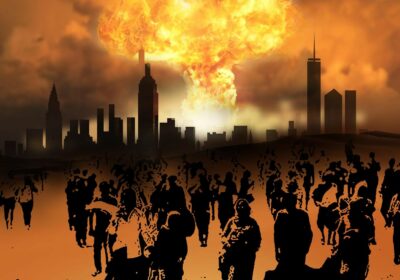
Leave a Reply